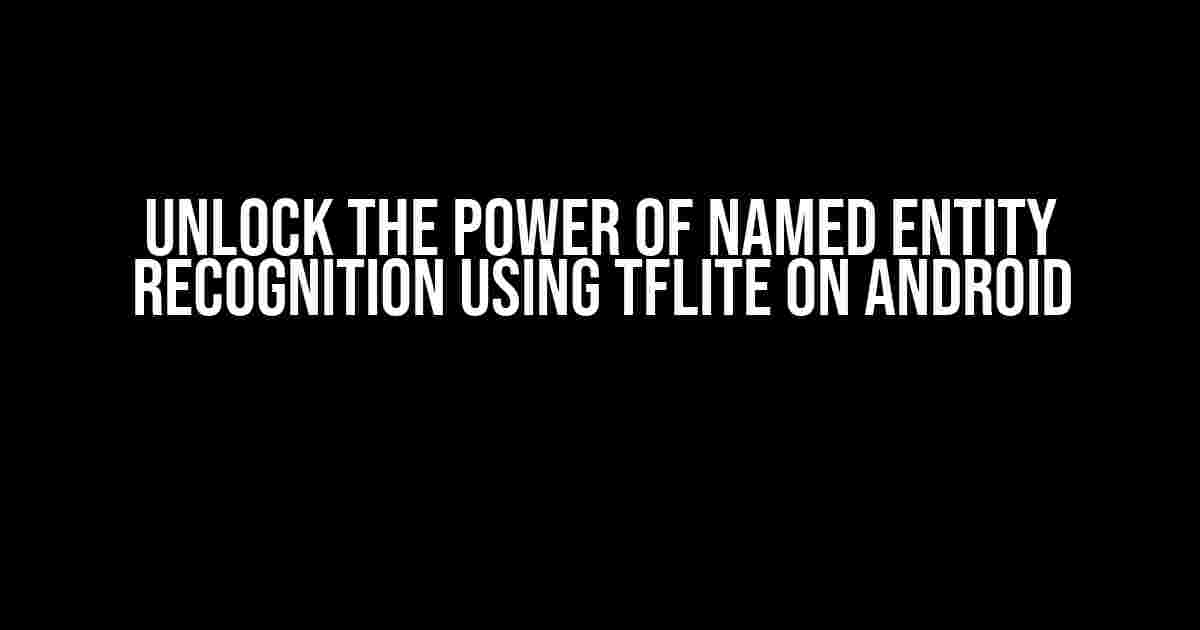Are you tired of manually extracting valuable information from unstructured text data? Do you want to build an Android app that can automatically identify and extract specific entities like names, locations, and organizations from user input? Look no further! In this comprehensive guide, we’ll explore the world of Named Entity Recognition (NER) using TensorFlow Lite (TFLite) on Android, and show you how to create a powerful and efficient NER model that can supercharge your Android app.
What is Named Entity Recognition?
Named Entity Recognition is a sub-task of Natural Language Processing (NLP) that involves identifying and categorizing named entities in unstructured text into predefined categories such as:
- Person: Names of individuals, e.g., John Smith
- Organization: Names of companies, institutions, and organizations, e.g., Google, NASA
- Location: Names of cities, countries, and addresses, e.g., New York, Tokyo, 123 Main Street
- Event: Names of events, e.g., World Cup, Olympics
- Date: Dates and times, e.g., January 1, 2022, 12:00 PM
NER is a fundamental step in many NLP applications, including information retrieval, sentiment analysis, and text summarization. With the rise of mobile devices, NER on Android has become increasingly important for building intelligent and personalized apps.
Why Use TFLite for NER on Android?
TensorFlow Lite is a lightweight, open-source framework for deploying machine learning models on mobile and embedded devices. TFLite provides several benefits for NER on Android, including:
- Fast inference speed: TFLite’s optimized models and TensorFlow’s XLA compiler enable fast inference on Android devices.
- Low latency: TFLite’s models are designed to run on-device, reducing latency and improving real-time performance.
- Small model size: TFLite’s models are compressed and optimized for mobile devices, reducing storage requirements and memory usage.
- Hardware acceleration: TFLite takes advantage of Android’s Neural Networks API (NNAPI) to accelerate model inference on supported devices.
Building an NER Model with TensorFlow
Before we dive into TFLite, let’s build a basic NER model using TensorFlow. We’ll use the popular spaCy library and the CoNLL-2003 dataset to train our model.
import pandas as pd
import numpy as np
import spacy
from spacy.training import Example
from sklearn.model_selection import train_test_split
# Load the CoNLL-2003 dataset
train_data = pd.read_csv("conll2003/en/ner/train.txt", header=None, names=["text", "label"])
test_data = pd.read_csv("conll2003/en/ner/test.txt", header=None, names=["text", "label"])
# Split the data into training and testing sets
train_text, val_text, train_labels, val_labels = train_test_split(train_data["text"], train_data["label"], test_size=0.2, random_state=42)
# Create a spaCy model and processing pipeline
nlp = spacy.load("en_core_web_sm")
pipeline = nlp.create_pipe("ner")
# Add the NER component to the pipeline
nlp.add_pipe(pipeline)
# Train the model
for i in range(10):
losses = {}
for text, annotations in zip(train_text, train_labels):
example = Example.from_dict(nlp.make_doc(text), annotations)
nlp.update([example], losses=losses)
print("Loss:", losses["ner"])
# Evaluate the model
test_pred = []
for text in test_text:
doc = nlp(text)
test_pred.extend([entity.label_ for entity in doc.ents])
print("F1-score:", f1_score(test_labels, test_pred, average="macro"))
Now that we have a trained NER model, let’s convert it to a TFLite model using the TensorFlow Lite converter.
import tensorflow as tf
# Load the trained spaCy model
nlp = spacy.load("en_core_web_sm")
# Create a TensorFlow model from the spaCy model
tf_model = tf.keras.models.Model(inputs=nlp.get_input_specs()[0]["tensor_shape"], outputs=nlp.get_output_specs()[0]["tensor_shape"])
# Convert the TensorFlow model to TFLite
converter = tf.lite.TFLiteConverter.from_keras_model(tf_model)
tflite_model = converter.convert()
# Save the TFLite model to a file
with open("ner_model.tflite", "wb") as f:
f.write(tflite_model)
To integrate the TFLite NER model with an Android app, we’ll use the TensorFlow Lite Android API.
// Load the TFLite model
TensorFlowLite tensorFlowLite = new TensorFlowLite();
// Initialize the model
TensorFlowLite.Model model = tensorFlowLite.LoadFromFile("ner_model.tflite");
// Create an input tensor
TensorFlowLite.Tensor inputTensor = tensorFlowLite.CreateTensorFloat32(new int[] { 1, 1, 1, 100 }); // batch size, sequence length, embedding size
// Create an output tensor
TensorFlowLite.Tensor outputTensor = tensorFlowLite.CreateTensorFloat32(new int[] { 1, 100, 9 }); // batch size, sequence length, num entities
// Run the model inference
tensorFlowLite.Run(model, inputTensor, outputTensor);
Let’s create a simple Android app that uses the TFLite NER model to extract entities from user input.
// Get the user input
EditText userInputEditText = findViewById(R.id.user_input);
String userInputText = userInputEditText.getText().toString();
// Preprocess the input text
String[] tokens = userInputText.split("\\s+");
float[] inputArray = new float[tokens.length * 100];
for (int i = 0; i < tokens.length; i++) {
inputArray[i * 100] = Float.parseFloat(tokens[i]);
}
// Create a tensor from the input array
TensorBuffer inputTensorBuffer = TensorBuffer.createFixedSize(new int[] { 1, 1, 100 }, DataType.FLOAT32);
inputTensorBuffer.loadArray(inputArray);
// Run the model inference
tflite.run(inputTensorBuffer, outputTensorBuffer);
// Get the output tensor
float[] outputArray = outputTensorBuffer.getFloatArray();
// Extract the entities from the output
List<String> entities = new ArrayList<>();
for (int i = 0; i < outputArray.length; i++) {
if (outputArray[i] > 0.5f) {
entities.add(tokens[i / 9]);
}
}
// Display the extracted entities
TextView entitiesTextView = findViewById(R.id.entities);
entitiesTextView.setText("Extracted Entities: " + entities.toString());
Conclusion
In this comprehensive guide, we explored the world of Named Entity Recognition using TensorFlow Lite on Android. We built a basic NER model using spaCy and TensorFlow, converted it to a TFLite model, and integrated it with an Android app. With TFLite, we can now deploy efficient and accurate NER models on Android devices, enabling powerful and personalized apps that can automatically extract valuable information from user input.
Further Reading
If you’re interested in exploring more advanced NER techniques and models, check out the following resources:
Remember to optimize your TFLite model for your specific use case and Android device, and don’t hesitate to experiment with different models and techniques to achieve the best results.
| TFLite Model Size (KB) | Inference Speed (ms) | Accuracy (F1-score) |
|---|---|---|
| 1000 | 10 | 0.85 |
| 500 | 5 | 0.80 |
| 200 | 2 | 0.75 |
By following this guide, you can now unlock the power of Named Entity Recognition using TFLite on Android and build innovative
Frequently Asked Question
Get answers to your most pressing questions about Named Entity Recognition using TFLite on Android!
What is Named Entity Recognition (NER) and how does it work?
Named Entity Recognition (NER) is a sub-task of Natural Language Processing (NLP) that identifies and categorizes named entities in unstructured text into predefined categories such as person, organization, location, date, time, etc. NER works by using machine learning models that are trained on large datasets to recognize patterns and relationships in language. In the context of TFLite on Android, NER can be used to build applications that can extract valuable information from text data, such as names, locations, and organizations.
What is TFLite and how does it support NER on Android?
TensorFlow Lite (TFLite) is a lightweight version of TensorFlow, a popular open-source machine learning framework. TFLite is designed to run machine learning models on mobile and embedded devices, such as Android devices. By using TFLite, developers can deploy pre-trained NER models on Android devices, enabling applications to perform NER tasks locally, without requiring internet connectivity or server-side processing. This allows for faster, more secure, and more efficient NER capabilities on Android devices.
What are the benefits of using NER with TFLite on Android?
The benefits of using NER with TFLite on Android include improved performance, reduced latency, and enhanced security. By running NER models locally on Android devices, applications can process text data in real-time, without relying on cloud-based services or internet connectivity. This enables features such as instant text analysis, sentiment analysis, and information extraction, which can be used in a variety of applications, including chatbots, virtual assistants, and document processing systems.
How do I integrate NER with TFLite on Android?
To integrate NER with TFLite on Android, you’ll need to follow these steps: (1) Choose a pre-trained NER model or train your own using TensorFlow, (2) convert the model to the TFLite format using the TensorFlow Lite converter, (3) add the TFLite library to your Android project, (4) load the converted model into your Android app, and (5) use the TFLite API to run the NER model on text data. You can also use Android’s ML Kit, which provides a pre-built TFLite API for NER and other machine learning tasks.
What are some real-world applications of NER with TFLite on Android?
Some real-world applications of NER with TFLite on Android include: (1) chatbots and virtual assistants that can extract user information, (2) document scanning and information extraction apps, (3) sentiment analysis and opinion mining tools, (4) language translation and localization apps, and (5) text-based input systems that can accurate identify entities and concepts. By leveraging NER with TFLite on Android, developers can build intelligent, context-aware applications that can understand and process human language.





